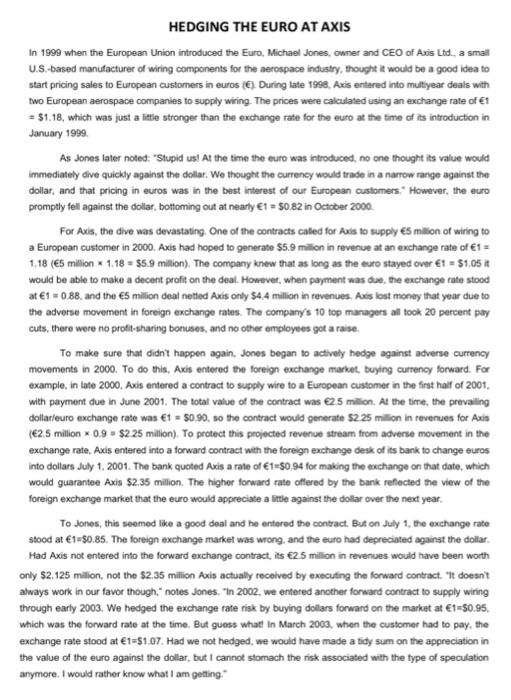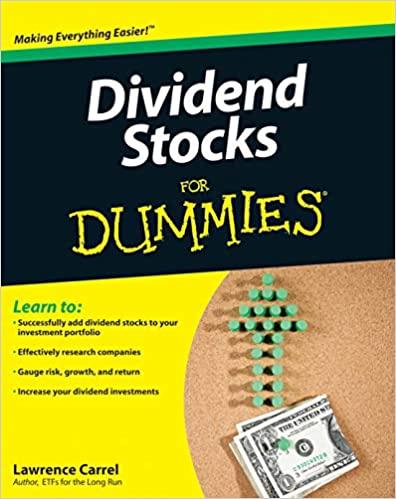Please help me solve the questions shown in the picture through the case study.
HEDGING THE EURO AT AXIS In 1999 when the European Union introduced the Euro, Michael Jones, owner and CEO of Axis Ltd., a small U.S.-based manulacturer of wiring components for the aerospace industry, thought it would be a good idea to start pricing sales to European customers in euros (6). During late 1998, Axis entered into multyear deals with two European aerospace companies to supply wiring. The prices were calculated using an exchange rate of 61 =$1.18, which was just a litle stronger than the exchange rate for the euro at the time of its introduction in January 1999. As Jones later noted: "Stupid us! At the time the euro was introduced, no one thought its value would immediately dive quickly against the dollar, We thought the currency would trade in a narrow range against the dollar, and that pricing in euros was in the best interest of our European customers," However, the euro promptly fell against the dollar, bottoming out at neatly 1=$0.82 in October 2000 . For Axis, the dive was devastating. One of the contracts called for Axis to supply e5 million of wiring to a European customer in 2000 . Axis had hoped to generate $5.9 million in revenue at an exchange rate of 1 = 1.18 ( 5 million 1.18=$5.9 million). The company knew that as long as the euro stayed over 1=$1.05 it would be able to make a decent profit on the deal. However, when payment was due, the exchange rate stood at 1=0.88, and the 5 million deal netted Axis only $4.4 million in revenues. Auis lost money that year due to the adverse movement in foreign exchange rates. The company's 10 top managers all took 20 percent pay culs, there were no profit-sharing bonuses, and no other employees got a raise. To make sure that didn' happen again, Jones began to actively hedge against adverse currency movements in 2000. To do this. Axis entered the foreign exchange market, buying currency forward. For example, in late 2000, Axis entered a contract to supply wire to a European customer in the first half of 2001. with payment due in June 2001. The total value of the contract was 62.5 million. At the time, the prevalling dollarieuro exchange rate was 61=$0.90, so the contract would penerate 52.25 million in revenues for Axis ( 2.5 million 0.9=$2.25 million). To protect this projected revenue stream from adverse movement in the exchange rate, Axis entered into a forward contract weh the foreign exchange desk of its bank to change euros into dollars July 1, 2001. The bank quoted Auis a rate of 61=50.94 for making the exchange on that date, which would guarantee Axis $2.35 million. The higher fonward rate oflered by the bank reflected the view of the foreign exchange market that the euro would appreciate a little against the dollar over the next year. To Jones, this seemed lake a good deal and he entered the contract. But on July 1, the exchange rate stood at 1=$0.85. The foreign exchange market was wrong, and the euro had depreciated against the dollar. only $2.125 milion, not the $2.35 million Axis actually received by executing the fonward contract. "it doesn't always work in our favor though," notes Jones. "in 2002, we entered another fonsard contract to supply wiring through early 2003. We hedged the exchange rate risk by buying dollars forward on the market at 1=$0.95. which was the forward rate at the time. But guess what In March 2003, when the customer had to pay, the exchange rate stood at 1=51.07. Had we not hedged, we would have made a tidy sum on the appreciation in the value of the euro against the dollar, but I cannot stomach the risk associated with the type of speculation anymore. I would rather know what I am getting." CASE DISCUSSION QUESTIONS 1. Was the loss that Axis suffered in 2000 the result of transaction exposure or translation exposure? 2. Apart from buying forward, how else might Axis have reduced its foreign exchange risk? 3. If Axis thinks that the value of the euro is going to appreciate, should it still hedge








